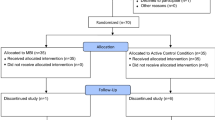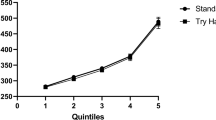Abstract
This paper reviews the concept of sustained attention, placing it within a theoretical framework in which deficits of attention are conceived of as deficits of controlled information processing. Two types of deficit of sustained attention are distinguished: perceptual sensitivity and perceptual criterion. These two deficits are linked to a model of human performance that links controlled processes to the energetic pools: arousal and activation. Perceptual sensitivity (d′) deficits are said to reflect arousal deficiencies, especially when observed in the early period of a vigil. Perceptual criterion deficits are associated with the activation pool and the response criterion measure β. Despite clear evidence of perceptual deficiency in the hyperactive children to a greater extent than in the control group, and that performance in d′ declined with time on task, a significant interaction failed to occur between group classification and time on task. Thus, the results failed to support the hypothesis of a sustained attention deficit in hyperactives, since if hyperactives have a sustained attention deficit, both d′ and β should have shown a significantly greater decline in the hyperactive group than in the controls with time on task.
Similar content being viewed by others
References
Anderson, R. P., Halcomb, C. G., & Doyle, R. B. (1973). The measurement of attentional deficits.Exceptional Children, 39, 539–543.
Broadbent, D. E. (1971).Decision and stress. London: Academic Press.
Brouwer, W. H., (1985).Limitations of attention after closed head injury. Doctoral dissertation, Rijks Universiteit Groningen.
Charles, L., Schain, R. J., Zelniker, T., & Guthrie, D. (1979). Effects of methylphenidate on hyperactive children's ability to sustain attention.Pediatrics, 64, 412–418.
Davies, D. R., & Parasuraman, R. (1982).The psychology of vigilance. London: Academic Press.
Douglas, V. I. (1983). Attentional and cognitive problems. In M. Rutter (Ed.),Developmental neuropsychiatry (pp. 280–329). New York: Guilford Press.
Douglas, V. I., & Peters, K. G. (1979). Toward a clearer definition of the attentional deficit of hyperactive children. In G. A. Hale & M. Lewis (Eds.),Attention and cognitive development (pp. 173–247). New York: Plenum Press.
Dykman, R. A., Ackerman, P. T., & Oglesby, D. M. (1979). Selective and sustained attention in hyperactive, learning disabled, and normal boys.Journal of Nervous and Mental Disease, 167, 288–297.
Fisk, A. D., & Schneider, W. (1981). Control and automatic processing during tasks requiring sustained attention: A new approach to vigilance.Human Factors, 23, 737–750.
Green, D. M., & Swets, J. A. (1966).Signal detection theory and psychophysics. New York: Wiley.
Klorman, R., Salzman, L. F., Pass, H. L., Borgstedt, A. D., & Dainer, K. B. (1979). Effects of methylphenidate on hyperactive children's evoked responses during passive and active attention.Psychophysiology, 16, 23–29.
Lachman, R., Lachman, J. L., & Butterfield, E. C. (1979).Cognitive psychology and information processing: An introduction. Hillsdale, NJ: Erlbaum.
Loiselle, D. L., Stamm, J. S., Maitinsky, S., & Whipple, S. (1980). Evoked potential and behavioral signs of attentive dysfunctions in hyperactive boys.Psychophysiology, 17, 193–201.
Molenaar, P. C. M., & van der Molen, M. (1986). Steps to a formal analysis of the cognitiveenergetic model of stress and human performance.Acta Psychologica, 62, 237–261.
Moraal, J. (1982). Age and information processing.Proceedings of the Annual Meeting of the Human Factors Society, Seattle, Washington.
Neuchterlein, K. H. (1983). Signal detection in vigilance tasks and behavioral attributes among offspring of schizophrenic mothers and among hyperactive children.Journal of Abnormal Psychology, 92, 4–28.
O'Dougherty, M., Neuchterlein, K., & Drew, B. (1984). Hyperactive and hypoxic children: Signal detection, sustained attention and behavior.Journal of Abnormal Psychology, 93, 178–191.
Ollman, R. (1977). Choice reaction time and the problem of distinguishing task effects from strategy effects. In S. Dornic (Ed.),Attention and performance (Vol. 6, pp. 99–113). Hillsdale, NJ: Erlbaum.
Parasuraman, R. (1979). Memory load and event rate control sensitivity decrements in sustained attention.Science, 205, 924–927.
Parasuraman, R. (1984). The psychobiology of sustained attention. In J. S. Warm (Ed.),Sustained attention in human performance (pp. 61–101). London: Wiley.
Parasuraman, R., & Davies, D. R. (1977). A taxonomic analysis of vigilance performance. In R. R. Mackie (Ed.),Vigilance: Theory, operational performance and physiological correlates (pp. 559–574). New York: Plenum Press.
Posner, M. (1978).Chronometric exploration of mind Hillsdale, NJ: Erlbaum.
Pribram, K. H., & McGuiness, D. (1975). Arousal, activation and effort in the control of attention.Psychological Review, 82, 116–149.
Prior, M., Sanson, A., Freethy, C., & Geffen, G. (1985). Auditory attentional abilities in hyperactive children.Journal of Child Psychology and Psychiatry, 26, 289–304.
Sanders, A. F. (1983). Towards a model of stress and human performance.Acta Psychologica, 53, 61–97.
Schachar, R., Rutter, M., & Smith, A. (1981). The characteristics of situationally and pervasively hyperactive children: Implications for syndrome definition.Journal of Child Psychology and Psychiatry, 22, 375–392.
Schneider, W., & Shiffrin, R. M. (1977). Controlled and automatic human information processing: I Detection, search and attention.Psychological Review, 84, 1–66.
Sergeant, J. A., & Scholten, C. A. (1983). A stages-of-information approach to hyperactivity.Journal of Child Psychology and Psychiatry, 24, 49–60.
Sergeant, J. A., & Scholten, C. A. (1985a). On resource strategy limitations in hyperactivity: Cognitive impulsivity reconsidered.Journal of Child Psychology and Psychiatry, 26, 97–109.
Sergeant, J. A., & Scholten, C. A. (1985b). On data limitations in hyperactivity.Journal of Child Psychology and Psychiatry, 26, 111–124.
Sergeant, J. A., & van der Meere, J. J. (1988). The diagnostic significance of attentional processing: Its significance for ADD(H) classification, a future DSM. In T. Sagvolden, H. M. Borggrevink, & T. Archer (Eds.),Attention deficit disorder and hyperkinetic syndrome (pp. 149–163). Hillsdale, NJ: Erlbaum Associates.
Sergeant, J. A., van Velthoven, R., & Virginia, A. (1979). Hyperactivity, impulsivity and reflectivity: An examination of their relationship and implications for clinical child psychology.Journal of Child Psychology and Psychiatry, 20, 47–60.
Shiffrin, R. M., & Schneider, W. (1977). Controlled and automatic human information processing: II Perceptual learning, automatic attending, and a general theory.Psychological Review, 84, 127–190.
Sostek, A. J., Buchsbaum, M. S., & Rapoport, J. L. (1980). Effects of amphetamine on vigilance performance in normal and hyperactive children.Journal of Abnormal Child Psychology, 8, 491–500.
Sternberg, S. (1969). Discovery of processing stages: Extensions of Donders'method. In W. G. Koster (Ed.),Attention and performance (Vol. 2, pp. 276–315). Amsterdam: North-Holland.
Stokx, L. C. (1984). Information processing and driving ability of patients with diffuse brain injury. InProceedings of the Fourth European Annual Conference on Human Decision Making and Manual Control (pp. 13–28). Soesterberg, The Netherlands: Instituut voor Zintuigfysiologie TNO.
Swets, J., & Kristofferson, A. B. (1970). Attention.Annual Review of Psychology, 21, 339–366.
Sykes, D. H., Douglas, V. L., & Morgenstern, G. (1973). Sustained attention in hyperactive children.Journal of Child Psychology and Psychiatry, 14, 213–220.
Sykes, D. H., Douglas, V. I., Weiss, G., & Minde, K. K. (1971). Attention in hyperactive children and the effect of methylphenidate (Ritalin).Journal of Child Psychology and Psychiatry, 12, 129–139.
van der Meere, J. J., & Sergeant, J. A. (1987). A divided attention experiment in pervasively hyperactive children.Journal of Abnormal Child Psychology, 15, 379–391.
van der Meere, J. J., & Sergeant, J. A. (1988). Acquisition of attention skill in pervasively hyperactive children.Journal of Child Psychology and Psychiatry, 29, 301–310.
Warm, J. S. (1984). An introduction to vigilance. In J. S. Warm (Ed.),Sustained attention in human performance (pp. 1–14). London: Wiley.
Author information
Authors and Affiliations
Additional information
The authors wish to thank L. Leertouwer for making the drawings. This research was supported by grants from the Netherlands Foundation for the Advancement of Pure Research (ZWO) and the Professor Duijker Fund.
Rights and permissions
About this article
Cite this article
van der Meere, J., Sergeant, J. Controlled processing and vigilance in hyperactivity: Time will tell. J Abnorm Child Psychol 16, 641–655 (1988). https://doi.org/10.1007/BF00913475
Revised:
Issue Date:
DOI: https://doi.org/10.1007/BF00913475




